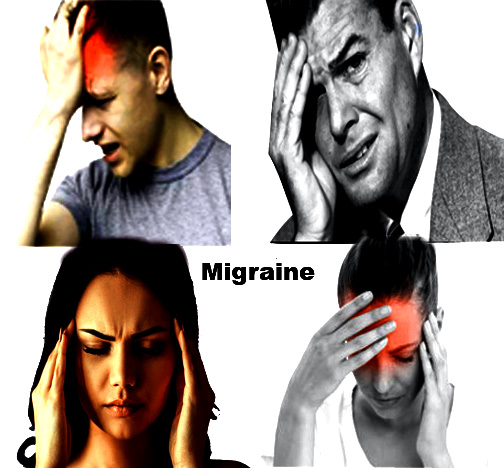 |
| Migraine |
Migraine:
Migraine is a special type of unbearable headache. It comes from the Greek word ‘hemicrania’ which means pain on one side of the head. It starts on one side of the head and then spreads all over the head. This disrupts the normal blood flow to the head. The arteries on the outside of the head swell at the onset of the headache. People who are more prone to migraines find their sounds, light, and smell unbearable. Headaches can be accompanied by nausea or vomiting. Sometimes there is a blurring of the eyes.
Causes:
Migraine
headaches are caused by differences in blood flow inside the head. When the
blood circulation decreases, the eyes become dark, and then when the blood circulation
increases suddenly, severe headache is felt. The cause of migraines is not yet
fully known. There are many reasons why migraines can occur. Such as:
hereditary or genetic, instability or anxiety, environmental effects, birth
control pills, and hormones. There may be other reasons as well. Such as:
alcohol, smoking, cheese, chocolate, coffee, soft drinks, extreme cold, working
in extreme heat or excessive light, prolonged exposure to computer monitors and
TVs, menstruation, sudden onset of dangerous news, or emotions. Talking on
mobile or talking too much, excessive travel and exercise. Migraine patients
but also suffering from sinus inflammation or suffering from a cold cough or
cold-related problems tend to have a gradual increase in their pain. Migraine
headaches increase in winter when the weather is foggy.
Types of migraine:
Migraines
can be divided into several categories. These include general, classical,
bacillary artery, ophthalmoplegic and hemiplegic migraines. Of these, general
and classical migraines are the most common.
General
migraine: General migraine is more common. This pain lasts for 4 to 72 hours.
Symptoms of a common migraine include headache, nausea or vomiting, tingling
headache. Fear of sound and light. This type of headache is relieved by pressing
on the ears, pressing the forehead, and pulling the hair of the head.
Classical
migraine: It is also more common. In the first stage, there may be flashing of
light in front of the eyes and blurred vision. There may be a tingling
sensation around the hands, feet, and mouth, weakness, and numbness on one side
of the body, followed by severe headaches. At first, it starts from one side and
spreads to all parts of the head. Severe headaches, sweating, nausea, or
vomiting make the body very weak.
Bacillaryartery migraine: This type of headache starts in the back of the head. It can
also, cause dizziness.
Ophthalmoplegic migraine: This type of headache starts from the surface of the eye and spreads
around the head. The result looks blurry. Can't look at the light so loves to
stay in the darkroom.
Hemiplegic migraine: In this headache the body becomes numb. This type of pain lasts for
several days.
Symptoms of migraine:
Mental
and nervous disorders can occur before the headache starts. At this time the
patient may be irritable, overzealous, calm, slow, depressed, hilarious,
drowsy, very conscious. Many times nausea or vomiting may occur. Once the
headache is over, the patient may become extremely tired and weak. May cause
loss of appetite and mental problems.
Diagnosis:
This disease can usually be identified by looking at the patient's symptoms.
However, X-rays, eye examinations, CT scans, etc. can be done to be sure.
Prevention:
The most important thing to do during a migraine pain is to get at least a few
hours of sleep in a dark and silent environment as possible.
Foods
that help to prevent migraines:
- Magnesium rich foods. Such as Brown rice, potato and barley are migraine resistant.
- Various fruits, especially dates and figs relieve pain.
- Regular consumption of green, yellow, and orange vegetables is beneficial.
- Calcium and vitamin D helps to prevent migraines. Sesame, flour, and beets are rich in calcium.
- You can eat ginger pieces or ginger juice mixed with water twice a day.
- It is better to stay in the sun for 10 minutes every day. If not possible, you can take vitamin D supplements with the advice of a doctor.
- Lack of a balance of estrogen hormone during menopause often causes headaches. Eat fiber-rich foods. Adhere to a low-fat diet.
Foods
not to eat:
- Tea, coffee and soft drinks, chocolate, ice cream, yogurt, milk, butter, tomatoes and pickles.
- Wheat foods, such as bread, pasta, bread, etc.
- Eggs, meat
- Apples, bananas and peanuts
- Onion
Treatment:
Consult
a doctor if you have severe headaches and recurrent headaches. Some medications
are effective in preventing recurrent headaches, while others are effective in
reducing headaches. It is possible to lead a normal life by taking these
medicines as per the advice of the doctor and besides these getting adequate
rest and avoiding stress can be helpful.




0 Comments